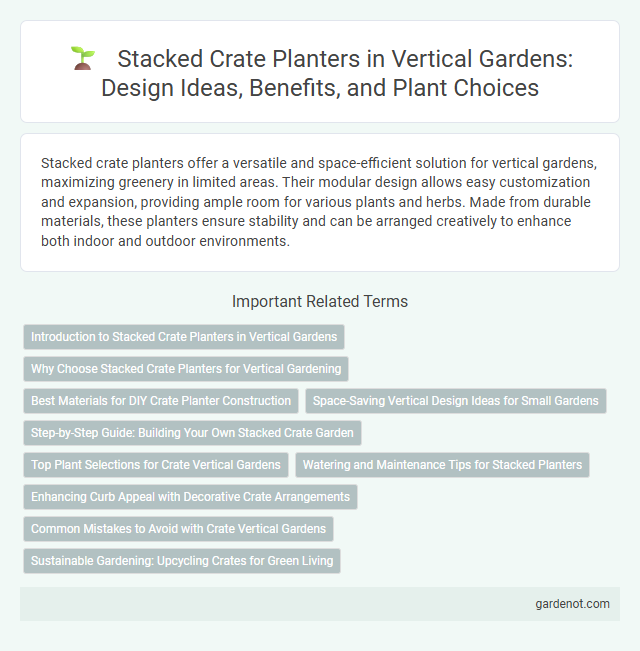Stacked crate planters offer a versatile and space-efficient solution for vertical gardens, maximizing greenery in limited areas. Their modular design allows easy customization and expansion, providing ample room for various plants and herbs. Made from durable materials, these planters ensure stability and can be arranged creatively to enhance both indoor and outdoor environments.
Introduction to Stacked Crate Planters in Vertical Gardens
Stacked crate planters offer a versatile and space-efficient solution for vertical gardens, utilizing wooden or plastic crates arranged in tiers to maximize growing area. These planters provide excellent drainage and airflow, promoting healthy root development and optimal plant growth. Ideal for small spaces and urban environments, stacked crate planters support a range of plants, from herbs to flowers, enhancing both aesthetics and sustainability in garden design.
Why Choose Stacked Crate Planters for Vertical Gardening
Stacked crate planters maximize vertical garden space by allowing multiple layers of plants in a compact footprint, ideal for small urban balconies or patios. Their modular design provides excellent drainage and airflow, promoting healthier plant growth and reducing soil-borne diseases. Durable, lightweight materials ensure easy customization and mobility, making stacked crate planters a versatile and sustainable choice for efficient vertical gardening solutions.
Best Materials for DIY Crate Planter Construction
Stacked crate planters thrive when constructed from durable, weather-resistant materials such as cedar, redwood, or treated pine, which resist rot and pests while providing structural stability. Using food-grade linings inside crates ensures soil containment without harmful chemical leaching, enhancing plant health and safety. Hardware like galvanized screws and rust-proof brackets further prolong the planter's lifespan, making these materials ideal for sustainable DIY vertical garden projects.
Space-Saving Vertical Design Ideas for Small Gardens
Stacked crate planters maximize limited space by utilizing vertical layers, ideal for small gardens and balconies. These modular systems allow easy customization and expansion, supporting diverse plant varieties while improving air circulation. Durable materials and compact design enhance urban gardening efficiency without compromising aesthetics or functionality.
Step-by-Step Guide: Building Your Own Stacked Crate Garden
Build your own stacked crate garden by selecting sturdy wooden crates, ensuring proper drainage by drilling holes in each crate base. Begin by stacking the crates securely, using brackets or screws to stabilize the structure, then fill each crate with quality potting soil suited for your chosen plants. Plant herbs, flowers, or vegetables in the soil-filled crates, placing taller plants in top crates for sunlight exposure and watering regularly to maintain healthy vertical growth.
Top Plant Selections for Crate Vertical Gardens
Succulents, herbs, and trailing plants like ivy or pothos are ideal top plant selections for stacked crate vertical gardens due to their adaptability and low maintenance needs. These plants thrive in limited soil depth, making them perfect for crates' compact spaces while providing vibrant textures and colors. Incorporating drought-tolerant species further enhances sustainability by reducing water requirements in vertical garden setups.
Watering and Maintenance Tips for Stacked Planters
Stacked crate planters require consistent watering to ensure all plants receive adequate moisture, with a focus on checking the top crates first as water trickles down through each level. Incorporating a drip irrigation system or self-watering reservoirs can optimize hydration while minimizing water waste. Regularly inspecting for drainage blockages and pruning overgrown plants supports healthy growth and prevents mold or rot in vertical garden setups.
Enhancing Curb Appeal with Decorative Crate Arrangements
Stacked crate planters transform outdoor spaces by adding vertical dimension and vibrant greenery, creating an eye-catching focal point for any garden or patio. Using decorative crate arrangements allows for customizable designs that complement various architectural styles while maximizing limited space. These modular planters enhance curb appeal by showcasing lush plants in a stylish, organized manner that draws attention and elevates the overall aesthetic.
Common Mistakes to Avoid with Crate Vertical Gardens
Stacked crate planters often suffer from poor drainage, leading to root rot and plant stress, so ensure each crate has sufficient holes or a drainage layer. Overloading crates with too much soil can cause structural instability and make the vertical garden prone to tipping over. Avoid planting species with different water and light requirements together, as it complicates maintenance and reduces overall plant health.
Sustainable Gardening: Upcycling Crates for Green Living
Stacked crate planters transform discarded wooden crates into functional vertical gardens, promoting sustainable gardening by reducing waste and repurposing materials. This eco-friendly approach supports green living through efficient space utilization and encourages the growth of diverse plants in urban environments. Upcycling crates enhances biodiversity while minimizing the carbon footprint associated with traditional garden containers.
Stacked crate planter Infographic

 gardenot.com
gardenot.com